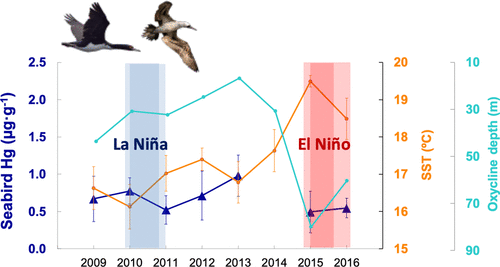当前位置:
X-MOL 学术
›
Environ. Sci. Technol.
›
论文详情
Our official English website, www.x-mol.net, welcomes your
feedback! (Note: you will need to create a separate account there.)
ENSO Climate Forcing of the Marine Mercury Cycle in the Peruvian Upwelling Zone Does Not Affect Methylmercury Levels of Marine Avian Top Predators
Environmental Science & Technology ( IF 10.8 ) Pub Date : 2021-11-19 , DOI: 10.1021/acs.est.1c03861 Marina Renedo 1 , David Point 1 , Jeroen E Sonke 1 , Anne Lorrain 2 , Hervé Demarcq 3 , Michelle Graco 4 , Daniel Grados 4 , Dimitri Gutiérrez 4 , Anaïs Médieu 2 , Jean Marie Munaron 2 , Alice Pietri 4 , François Colas 5 , Yann Tremblay 3 , Amédée Roy 3 , Arnaud Bertrand 3 , Sophie Lanco Bertrand 3
Environmental Science & Technology ( IF 10.8 ) Pub Date : 2021-11-19 , DOI: 10.1021/acs.est.1c03861 Marina Renedo 1 , David Point 1 , Jeroen E Sonke 1 , Anne Lorrain 2 , Hervé Demarcq 3 , Michelle Graco 4 , Daniel Grados 4 , Dimitri Gutiérrez 4 , Anaïs Médieu 2 , Jean Marie Munaron 2 , Alice Pietri 4 , François Colas 5 , Yann Tremblay 3 , Amédée Roy 3 , Arnaud Bertrand 3 , Sophie Lanco Bertrand 3
Affiliation

|
Climate change is expected to affect marine mercury (Hg) biogeochemistry and biomagnification. Recent modeling work suggested that ocean warming increases methylmercury (MeHg) levels in fish. Here, we studied the influence of El Niño Southern Oscillations (ENSO) on Hg concentrations and stable isotopes in time series of seabird blood from the Peruvian upwelling and oxygen minimum zone. Between 2009 and 2016, La Niña (2011) and El Niño conditions (2015–2016) were accompanied by sea surface temperature anomalies up to 3 °C, oxycline depth change (20–100 m), and strong primary production gradients. Seabird Hg levels were stable and did not co-vary significantly with oceanographic parameters, nor with anchovy biomass, the primary dietary source to seabirds (90%). In contrast, seabird Δ199Hg, proxy for marine photochemical MeHg breakdown, and δ15N showed strong interannual variability (up to 0.8 and 3‰, respectively) and sharply decreased during El Niño. We suggest that lower Δ199Hg during El Niño represents reduced MeHg photodegradation due to the deepening of the oxycline. This process was balanced by equally reduced Hg methylation due to reduced productivity, carbon export, and remineralization. The non-dependence of seabird MeHg levels on strong ENSO variability suggests that marine predator MeHg levels may not be as sensitive to climate change as is currently thought.
中文翻译:

秘鲁上升流区海洋汞循环的 ENSO 气候强迫不影响海洋鸟类顶级捕食者的甲基汞水平
气候变化预计会影响海洋汞 (Hg) 生物地球化学和生物放大作用。最近的建模工作表明,海洋变暖会增加鱼类中的甲基汞 (MeHg) 水平。在这里,我们研究了厄尔尼诺南方涛动 (ENSO) 对来自秘鲁上升流和氧气最低区的海鸟血液时间序列中汞浓度和稳定同位素的影响。2009-2016 年,拉尼娜(2011)和厄尔尼诺条件(2015-2016)伴随着高达 3°C 的海面温度异常、氧化跃层深度变化(20-100 m)和强烈的初级生产梯度。海鸟 Hg 水平是稳定的,并且与海洋学参数和鳀鱼生物量(海鸟的主要膳食来源(90%))没有显着共同变化。相比之下,海鸟 Δ 199Hg(海洋光化学甲基汞分解的代表)和 δ 15 N 显示出强烈的年际变化(分别高达 0.8 和 3‰),并且在厄尔尼诺现象期间急剧下降。我们认为,厄尔尼诺现象期间较低的 Δ 199 Hg 表示由于氧跃层加深而导致的 MeHg 光降解减少。由于生产率、碳输出和再矿化的降低,该过程通过同样减少的 Hg 甲基化来平衡。海鸟甲基汞水平不依赖于强烈的 ENSO 变异性表明海洋捕食者甲基汞水平可能不像目前认为的那样对气候变化敏感。
更新日期:2021-12-07
中文翻译:

秘鲁上升流区海洋汞循环的 ENSO 气候强迫不影响海洋鸟类顶级捕食者的甲基汞水平
气候变化预计会影响海洋汞 (Hg) 生物地球化学和生物放大作用。最近的建模工作表明,海洋变暖会增加鱼类中的甲基汞 (MeHg) 水平。在这里,我们研究了厄尔尼诺南方涛动 (ENSO) 对来自秘鲁上升流和氧气最低区的海鸟血液时间序列中汞浓度和稳定同位素的影响。2009-2016 年,拉尼娜(2011)和厄尔尼诺条件(2015-2016)伴随着高达 3°C 的海面温度异常、氧化跃层深度变化(20-100 m)和强烈的初级生产梯度。海鸟 Hg 水平是稳定的,并且与海洋学参数和鳀鱼生物量(海鸟的主要膳食来源(90%))没有显着共同变化。相比之下,海鸟 Δ 199Hg(海洋光化学甲基汞分解的代表)和 δ 15 N 显示出强烈的年际变化(分别高达 0.8 和 3‰),并且在厄尔尼诺现象期间急剧下降。我们认为,厄尔尼诺现象期间较低的 Δ 199 Hg 表示由于氧跃层加深而导致的 MeHg 光降解减少。由于生产率、碳输出和再矿化的降低,该过程通过同样减少的 Hg 甲基化来平衡。海鸟甲基汞水平不依赖于强烈的 ENSO 变异性表明海洋捕食者甲基汞水平可能不像目前认为的那样对气候变化敏感。











































 京公网安备 11010802027423号
京公网安备 11010802027423号